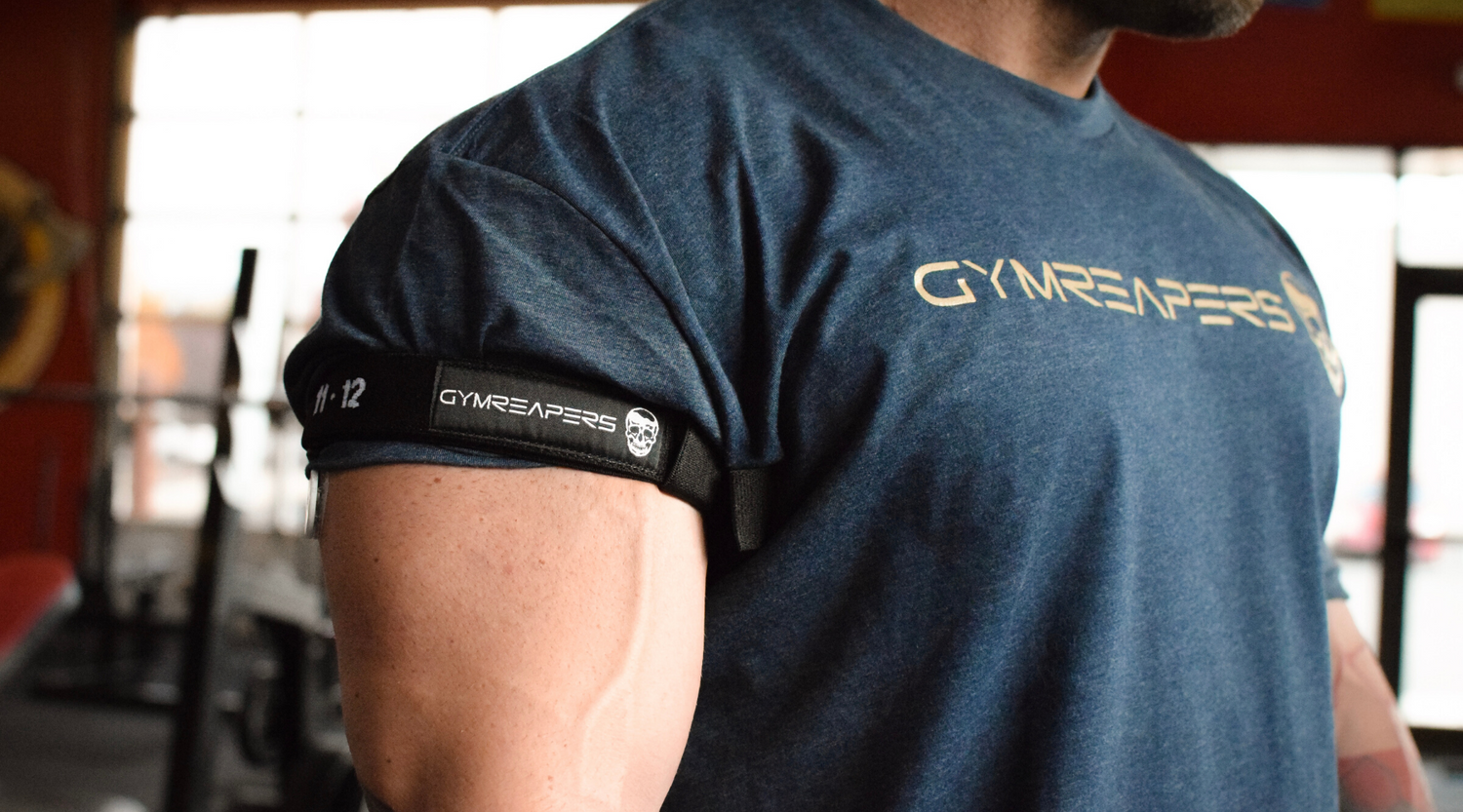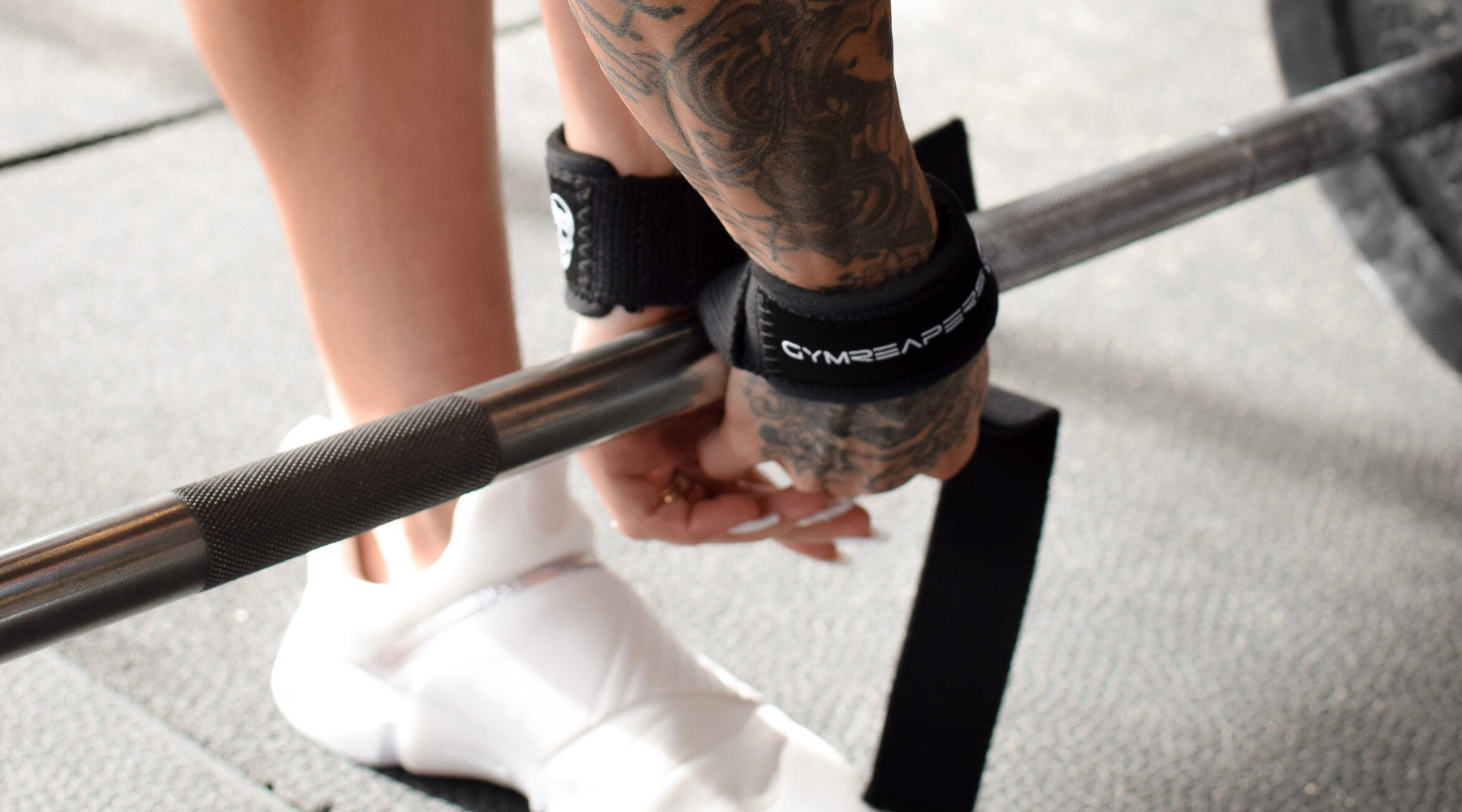Blood flow restriction training has been getting a lot of attention lately, some even calling it a revolutionary new training system. But why is that?
One of the biggest reasons is that there’s a lot of promising research showing blood flow restriction training (BFR) is a viable method for building muscle (1). In this article, you’ll discover more details about what blood flow restriction training is, how it works, and how you can use it to your advantage.
First, let’s answer the question of what is blood flow restriction training (also called occlusion training)? Put simply, it’s a method where you restrict blood flow to a certain part of the body and then train it.
It begins when you secure occlusion straps (or any type of tourniquet) over a target muscle, similar to if you were getting blood drawn, but instead of getting a needle injected into your arm, you start performing contractions.
Sounds kind of odd, right? After all, what we know about building muscle and strength has been pretty standard and proven, so if it works why challenge that, right? Well, in a moment, we’ll be going into more detail about the specifics of how to implement BFR training and why it’s so powerful. You’ll discover how it can totally change your perspective and your workouts.
It’s okay to be skeptical though because it’s rare that a new technique comes along that isn’t just another gimmick. Beyond having quite a bit of research behind it, it's important to note occlusion training is simply a new technique to achieve something we’ve always known to promote hypertrophy. So let’s get into what’s actually going on with BFR training.

How does BFR training work?
Encouraging more blood flow to the muscle is a good strategy for building muscle. Bodybuilders have known this for a while. Occlusion straps will simply give your muscles an increase in size, provided you use them correctly. But what exactly is happening here?
Researchers can’t say for certain yet. After all, researchers are still examining what exact mechanisms cause the muscle to grow in general. However, there are a number of theories that have come out of the various studies on the topic. The predominant theory involves something called metabolic stress.
According to one study, metabolic stress “stimulates a subsequent increase in anabolic growth factors, fast-twitch fiber recruitment, and increased protein synthesis through the mammalian target of rapamycin (mTOR) pathway” (2).
So anytime you can stimulate any of those anabolic growth factors/metabolites listed, that’s going to be great for muscle growth.
In the same study, researchers have found that BFR training is “a good way to increase the accumulation of metabolites”. Therefore, many think this is the main mechanism through which BFR training promotes muscle growth. Interestingly enough though, there have been instances where metabolites did not accumulate yet hypertrophy still occurred.
Therefore, it’s thought that cellular swelling induced by BFR may also contribute. That said, researchers stated that when both cellular swelling and metabolite accumulation are present, the hypertrophic effects are greater (2).
BFR training also increases EMG (electromyography) activity, according to the above-mentioned research published in the International Journal of Sports Medicine.
Granted, EMG activity isn’t the end all be all of the muscle mass. Just because “exercise A” elicits higher EMG than “exercise B” doesn’t implicitly mean that “exercise A” is better for building muscle. The reason being is that there are numerous other factors at play. That said, increased EMG is positively correlated with muscle growth.
Lastly, according to a study in the Journal of Strength and Conditioning Research, similar muscle gains can be obtained using a significantly lighter weight. This could be because low load BFR training may "stimulate a level of metabolic stress which you’d normally need a much higher load to induce.”
And that’s where BFR training really shines — you can induce an equal amount of muscle growth using significantly lighter weights. Let’s talk about why this is so important.

Buy Gymreapers BFR Bands
Why should I use BFR bands for training?
After all, why not just train hard using heavier weights? Especially if strength and muscle gains are similar? As much as the meathead in you just wants to lift heavy all the time, you should consider switching it up sometimes and opting for the lighter weights.
If you’ve been weightlifting for a while, you probably know that training heavy all the time can take its toll on your joints. And if your joints are cranky, you can’t train hard. Consequently, your results suffer. And wear and tear can become exacerbated over the long term.
Lifting heavy things can certainly be safe. But even when done properly, lifting heavy things will always yield more inherent risk and stress on the joints than lifting lighter things. Using a light load to achieve the same training effect as a heavy load means you can reduce stress on the joints without sacrificing muscle gains.
Keeping your joints healthy should take high priority even if your sole goal is to build as much muscle as possible. Taking a break from the heavy weights will not only give cranky joints time to recover without slowing you down but may also be helpful in rehabbing the joint.
BFR is especially practical when it comes to the elbow based movements. Lots of heavy arm work can really piss off the elbows. So even if you don’t have cranky elbows yet, adding in BFR bands to your arm training will make your arm work safer in the long term.
How to use BFR bands for training
The first thing you should do is decide which exercise you're doing. Then you want to put the straps around the appropriate muscle. You should never place the straps around a joint.
For example, if you’re working on your deltoids, don’t wrap your armpit. We’ll cover placement and its importance in the next section.
When applying the straps, you want the tightness to be about a 7 out of 10 on the adjustment indicator. The idea is to occlude the veins, but not the arteries. It’s important to know that because you definitely don’t want to have the straps too tight.
Select a weight that is 20 to 30 percent of your repetition maximum (RM) for that exercise. Then start repping it out. Focus on squeezing the muscle on the way up and stretching it on the way down. It’s really that simple. If the weight is 30 percent of one RM, that should put you around 30 reps per set.
What exercises work best with BFR bands?
Coming back to the topic of avoiding straps on joints. BFR only works well on the limbs. So any single joint exercise involving a muscle located on the extremities is fair game. BFR works particularly well for bicep curls, tricep pushdowns, leg extensions, and hamstring curls.
With upper limb exercises, you’ll wrap the BFR strap just below your deltoid. Whereas with lower limb exercises (squats, leg extensions, etc.) you’ll be wrapping the BFR strap on your upper thigh.
BFR training is a really useful way to make training safer while yielding great results. We’re still learning about the in-depth mechanics of how it actually works, but one thing that’s clear is that it does work!
Where can I get occlusion (BFR) bands?
There may be several options of BFR bands on the market, however, Gymreapers offers a full set (or a 4 pack) of high-quality straps. There are a number of design features that will make your occlusion training easier and more effective.
Some cool features of the Gymreapers occlusion bands are that they have easy fastening options and feature easy to read measurements. They’re made from durable elastic to make training comfortable and impactful. If you’ve been wanting to try BFR training, pick up a pair today!
References
- Armstrong, G. (2019). Build Strength and Muscle Fast with Occlusion Training. Retrieved 27 November 2019, from https://www.scientificamerican.com/article/build-strength-and-muscle-fast-with-occlusion-training/
- Loenneke, J., Wilson, G., & Wilson, J. (2009). A Mechanistic Approach to Blood Flow Occlusion. International Journal Of Sports Medicine, 31(01), 1-4. doi: 10.1055/s-0029-1239499
Disclaimer: Occlusion bands can cause serious injury if not used properly. You should consult with a physician if you have questions or concerns, and read all instructions/warnings before use.










Hinterlasse einen Kommentar
Alle Kommentare werden vor der Veröffentlichung geprüft.
Diese Website ist durch hCaptcha geschützt und es gelten die allgemeinen Geschäftsbedingungen und Datenschutzbestimmungen von hCaptcha.